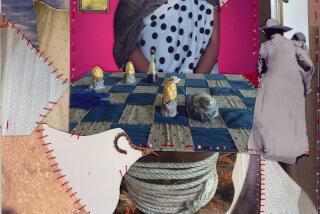HEALTH : Dr. Dreams : Stanford Scientist Stephen LaBerge Is Sleeping on the Idea That Dreams Are a Tool for Bettering Our Lives
- Share via
Few people relish going to sleep as much as Stephen LaBerge. Little wonder, considering that his dream adventures include jumping off mountains, soaring over distant planets and cruising the sun.
LaBerge, a researcher and psychophysiologist at Stanford University’s Sleep Research Center, claims he can wake up inside his dreams, often choosing to alter the content. While asleep, he says, he can do such things as embrace scary monsters, turning them into docile pussycats, or opt to fly instead of walk.
“Once I know it’s a dream, I’m aware that rules of the real world no longer apply, and I’m free to do all kinds of impossible things,” explains LaBerge, a leading dream researcher and the nation’s foremost expert on the little-understood subject of lucid dreaming.
The term lucid was first coined in 1913 by Dutch psychiatrist Frederik van Eeden to describe dreams in which the dreamer is aware he is dreaming. Although his studies indicate only about one in 10 people have lucid dreams regularly, LaBerge believes it is a skill almost anyone can learn.
More commonly, sleep researchers seek cures for disease and disorders. LaBerge’s work is unusual because it is the nation’s only ongoing laboratory program studying lucid dreaming. He is trying to solve a mystery: how our higher reflective consciousness connects with the brain. And to solve this puzzle, he must map what physiological changes take place, and in which parts of the brain.
‘Promoting Personal Growth’
LaBerge maintains that lucid dreaming “has considerable potential for promoting personal growth and self-development, enhancing self-confidence, improving mental and physical health, facilitating creative problem solving and helping people progress on the path of self-mastery.” This belief, he says, enables him to trudge on with research despite early skepticism within the scientific community and the seemingly endless personal financial struggle to fund his work.
Renowned sleep researcher Dr. William Dement of the Stanford’s Sleep Research Center describes LaBerge as “very intelligent and more dedicated than most people. Without that dedication he wouldn’t have survived, because he is working in an area outside the biomedical and psychological mainstream. LaBerge is taking the state of dreaming to a new level of potential for man to exploit.”
But not everyone agrees with LaBerge’s approach to lucid dreaming. “It’s fine to become conscious in your dreams, but to manipulate your dreams with nice, Pollyanna endings is repressive. A bad dream is a symptom of something upsetting, a warning sign. Rather than pushing the conflict under the rug, you should be paying attention to the nightmare,” says San Francisco psychologist Gayle Delaney, co-director of the Delaney and Flowers Center for the Study of Dreams.
Others think arguments about manipulating dreams miss a crucial point. “LaBerge’s work goes way beyond whether you should use dreams for this or that,” observes Harry Fiss, an experimental psychologist and clinician at the University of Connecticut’s psychiatry department.
“One value of LaBerge’s work is that it will enhance our theoretical understanding of the human mind and how it functions. And what we learn about the brain has residual benefits such as treating diseases and developing medications,” he adds.
Such comments aren’t surprising, given LaBerge’s extensive scientific background. He entered the University of Arizona with advanced standing in chemistry and calculus, completing a mathematics degree in two years. Woodrow Wilson Fellowship in hand, LaBerge headed for Stanford, where he passed qualifying exams for a doctoral program in chemical physics.
But Stephen LaBerge is not a nerd, as his resume alone might suggest. Boyishly good looking at 41, his blue eyes are intense, his gestures expansive. And he enjoys a good laugh more than most people.
In his sleep laboratory in an old building off the Stanford Quad, LaBerge’s subjects nod off, outfitted with goggles and a hatful of electrodes. Electronic equipment transmits data including brain waves, eye movement, respiration, and heart rate to graphs and computers next door.
His research indicates that during dreams, the body sleeps but “from the point of view of your brain, it’s actually living the dream, not merely imagining it,” LaBerge says. The data enables him to image computer patterns of brain activity. He is especially eager to understand how activated the brain is during Rapid Eye Movement, or REM, sleep and which hemispheres are involved.
To teach lucid dreaming, LaBerge uses various exercises to help people become conscious of dreams. To remember to regularly do something in the future, subjects may be asked to check automobile mileage throughout the day. LaBerge said the daytime question, “How do I know I’m not dreaming now?,” often prompts people to ask the same question when dreaming. And to improve dream recall, LaBerge recommends remembering at least one dream per night, recording the dream, reading it over and reflecting upon the content. “The idea is to see what is dreamlike about the dreams. For example, some people regularly fly in their dreams. You have to say to yourself, ‘Next time I find myself flying, I will know I am dreaming.’ ”
Rapid-Fire Thoughts
Co-workers at the lab describe LaBerge as an appreciative colleague. One challenge, however, is keeping up with his rapid-fire thought process. “I do have to stop him sometimes and say, ‘Wait a minute, I can’t follow where you are going with this idea,’ ” said Lynne Levitan, a technician who has worked with LaBerge for many years.
His wife, Laurie, a lucid dreamer, sometimes has a similar problem. “All through college, people told me I was brilliant and intelligent and I got A’s. But sometimes, with Stephen, I feel stupid. He thinks outside the pale of the usual intelligent person,” she observes.
There was a time when LaBerge didn’t relate well to people. It was lucid dreaming, he says, that brought him a long way from his solitary childhood. The son of a U.S. Air Force colonel, LaBerge’s family moved frequently. He developed an early interest in science and the world of thought, spending a great deal of time closeted in his room, reading. “I was a complete introvert, and had no social skills whatsoever,” he recalls. Most of his junior high days were spent making rockets and bombs with his chemistry set.
He was about 5 years old when he had his first lucid dream. He was underwater and could see the ocean roof above, causing him to worry, “How can I breathe?” Then, he recalls, “I realized it wasn’t real water. It was only dreamwater . And I immediately knew I wasn’t going to drown, and I could explore sunken ships and rescue princesses and find pirate chests full of emeralds and rubies.”
Since this was far more interesting than real life, young Stephen tried to return to the same scene every night, “just like a Saturday morning serial.” Lying in bed, listening to the whir of the electric fan, he would will a return to the ocean depths.
The first lucid dream of his adult life didn’t occur until 1970 when he flew off K-2, the highest peak in the Karakoram range. By then LaBerge was, in his wife’s words, “a hippie boy.” Hitting California in 1967, “I couldn’t help becoming involved in the ferment of the interest in consciousness,” he said. He experimented briefly with psychedelic drugs, studied Tibetan Buddhism, Zen meditation, t’ai chi and Jungian analysis. Then, a realization changed the course of his life.
Another World
“From early childhood, I was interested in understanding how the world worked, and assumed I would be some kind of physical scientist or chemist. But the truth was, I didn’t know there was another kind of world, the inner world, that was just as interesting, if not more relevant, than what was going on in the outside world,” he said.
Taking a leave of absence from his studies, LaBerge worked as a psychopharmacology and chemistry researcher. Seeking a way to combine interests in physical science and psychology, he approached Dement at Stanford’s Sleep Research Center, and designed a course of studies resulting in a Ph.D. in psychophysiology.
It hasn’t been an easy road. In the early days, LaBerge had to prove he was awake while dreaming. Dreams are most vivid during REM sleep, a state characterized by intense brain activity and a great deal of eye movement.
At first, LaBerge, hooked up to a polysomnograph machine, signaled lucidity by moving his eyes left to right. When critics suggested that perhaps LaBerge was only dreaming he was moving his eyes, he went back to the drawing board.
Placing electrodes on his forearms to measure muscle activity, LaBerge clenched one fist in a predetermined sequence: left, left, left, then left, right, left, left, Morse code for his initials. “No one has suggested that those were just random twitches,” LaBerge laughs.
There also has been financial hardship. Although grateful for past support from the Institute for Human Development in Ojai, LaBerge terms his current lack of funding as “desperate.” Responsible for raising money to cover research costs, he currently owes Stanford $20,000 for last year’s expenses.
LaBerge’s lab operation bears little resemblance to Cedars-Sinai Medical Center. Much of his work is conducted in a smallish room jammed with computers and other electronic equipment. Next door, in a room not much bigger than a closet, dreamers are stretched out on cots and hooked up to monitoring devices.
His dilemma is shared by many scientists whose research doesn’t involve curing a major disease. “It is certainly important to be looking for cures to medical disorders, but it is equally important to conduct research on human health and well-being,” LaBerge says.
Changed Focus
Indeed, lack of financial support changed his focus, causing him to write a book, “Lucid Dreaming: The Power of Being Awake & Aware in Your Dreams” (Ballantine), give lectures and hold workshops to raise money. “Had I been able to get funding, I would have stayed solely a researcher, which is really what I am temperamentally suited for,” he says. A self-described introvert, LaBerge notes his new direction caused him to become outgoing, relatively at ease socially.
With an eye toward supporting research and gaining more visibility, LaBerge recently founded the Lucidity Institute, a nonprofit organization with a quarterly newsletter. He also has invented DreamLight, lucid dream induction goggles that pick up eye movements indicating REM sleep, and flash a red light bright enough to remind sleepers they are dreaming.
In the meantime, LaBerge and his wife, Laurie, who holds a master’s degree in dance, are definitely not your basic yuppies. Other than books, the couple’s only valuable belongings consist of a piano, a few antiques and a computer. Some time ago, Laurie LaBerge gave up choreographing and performing because both efforts paid too little. Currently she works as a word processor, teaching dance in the evenings.
Although subsidizing research is a constant worry, the lack of material possessions isn’t an issue. “I have high-tech tastes,” LaBerge says. “If I had $100 million, I would spend it on research equipment, rather than a yacht.”
His wife concurs. “It’s important to have beauty around me,” she says, alluding to lush greenery outside the couple’s modest rented home, “but I’m not interested in collecting things.”
‘An Odd Couple’
Over the years, the scientist and the dancer have become something of an “odd couple.” They met during LaBerge’s hippie phase, listening to classical music all day long, vacationing in the mountains and reading poetry. By Laurie LaBerge’s accounts, Stephen was a good artist. He even choreographed one of her dance pieces.
Those days have given way to the overworked researcher who is commonly at the computer until 2 a.m. Currently, the big treat is finding time to watch a video together or take a walk.
Nevertheless, it is worth it. “Stephen isn’t a computer hack. He’s a very warm person. He is very idealistic. And he has one of the most far-reaching minds I have ever encountered,” Laurie LaBerge says.
And LaBerge isn’t complaining. He hopes that a few more years of research will refine techniques, making it possible for large segments of the population to enjoy lucid dreaming. “There has been a burden involved in doing this work. But all along, I have felt it is important that I do it. I feel that accomplishing this will lead to a betterment of humanity in some way.”


